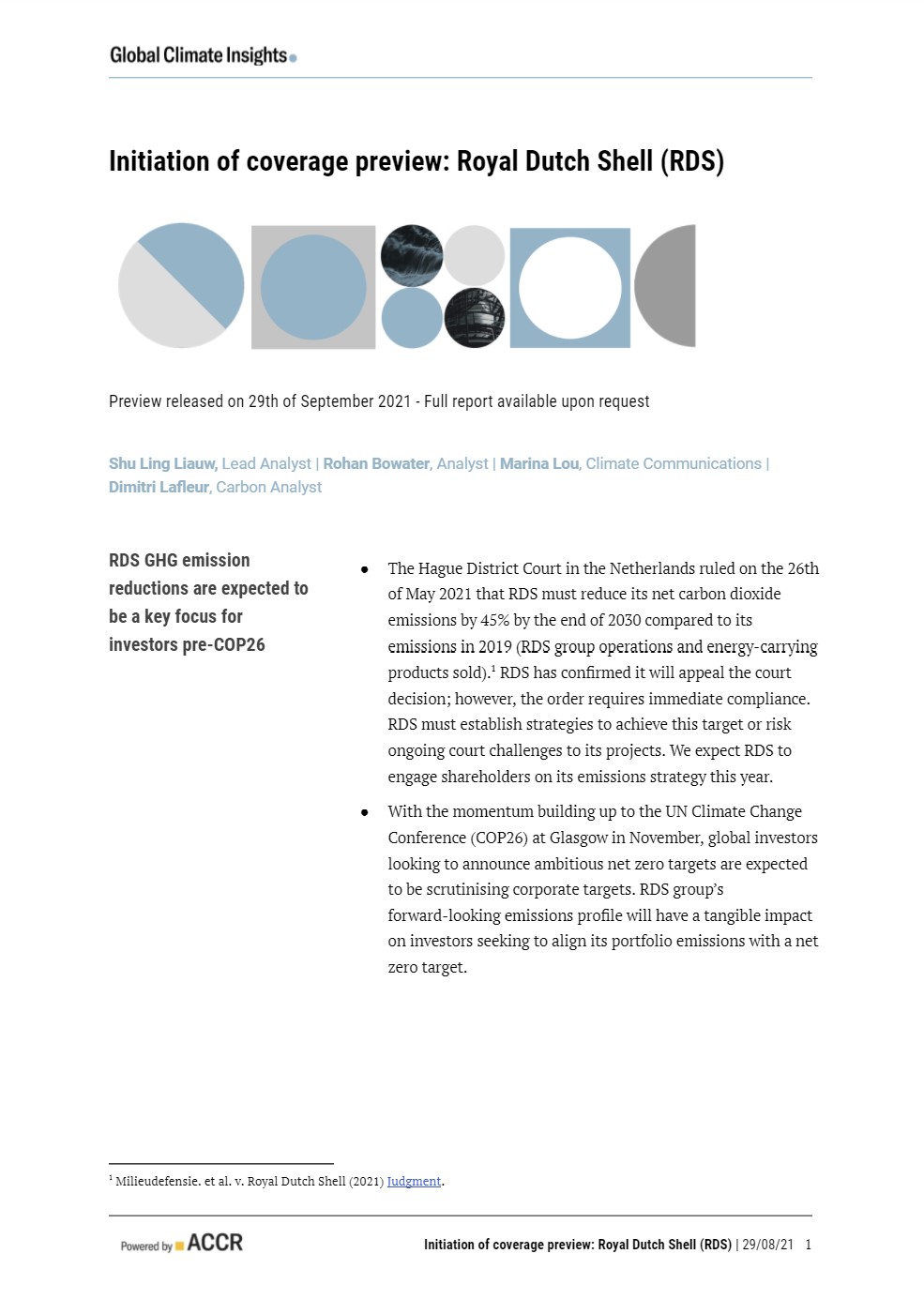PREVIEW Initiation of coverage: Royal Dutch Shell (RDS)

This is a preview of our comprehensive two part report on RDS, which will be publicly available mid-October 2021. For an exclusive investor briefing and access to the full report prior to public release, please contact us at marina.lou@globalclimateinsights.org.
RDS GHG emission reductions are expected to be a key focus for investors pre-COP26
- The Hague District Court in the Netherlands ruled on the 26th of May 2021 that RDS must reduce its net carbon dioxide emissions by 45% by the end of 2030 compared to its emissions in 2019 (RDS group operations and energy-carrying products sold).[1] RDS have confirmed they will appeal the court decision, however, the order requires immediate compliance. RDS must establish strategies to achieve this target or risk ongoing court challenges to its projects. We expect RDS to engage shareholders on its emissions strategy this year.
- With the momentum building up to the UN Climate Change Conference (COP26) at Glasgow in November, global investors looking to announce ambitious net zero targets are expected to be scrutinising corporate targets. RDS group’s forward-looking emissions profile will have a tangible impact on investors seeking to align its portfolio emissions with a net zero target.
At Global Climate Insights, we identify the substance of climate transition plans
- Climate transition targets and strategies will have a significant impact on company outlook and valuation. To date, disclosures to the market have not received the same level of scrutiny as earnings performance and forecasts.
We seek to understand what corporate plans mean for absolute emissions
- At Global Climate Insights we review sustainability and climate disclosure, along with key financial documents, to understand the substance of company transition plans. In this report we take RDS’ own climate transition targets and market share aspirations for future fuels to forecast what this could deliver in terms of absolute emissions reduction from now until Financial Year (FY) 2050.
- To build our forecasts, we do not take a view on the price of commodities, or short-term demand and supply changes. We look at the long-term technology trends that are necessary to achieve the 1.5°C ambition under the Paris Agreement. We reference key scenarios that provide a good indication of sectoral outlook including IEA NZE, the IPCC 1.5°C Special Report and Sixth Assessments.
We forecast emissions will continue to increase under RDS’ strategy “Powering Progress”
- Under RDS’ current decarbonisation strategy, we forecast annual absolute emissions (pre-Carbon Capture Utilization and Storage, carbon offsets and divestments) will continue to rise until FY30. By FY30, net emissions are forecast to increase 4%, exceeding the 45% reduction required by the court.
- Our RDS energy and GHG emissions forecasts use a FY19 baseline to account for the impacts of COVID-19 in FY20.
- We find RDS' transition strategy is still materially driven by fuels that will increase emissions, producing a growth strategy that will not truly align with a decarbonising world.
RDS cumulative emissions between FY21 and FY50 utilise 8.6% of the remaining global carbon budget
- As of FY19, RDS has produced an estimated 115.1 Gt CO2e in cumulative emissions, 3% of total global emissions.[2]
- Under its current strategy we estimate that RDS will further produce cumulative emissions of ~53.3 Gt CO2e by FY50 - 8.6% of the remaining global carbon budget.[3]
- The company’s role in warming our climate has been significant - the cost of which has yet to be fully reflected on its accounts (provisions, impairments, earnings reduction).
Our forecasts indicate that under its strategy RDS may miss its own FY30, FY35 and FY50 carbon intensity targets
- RDS targets a 20% reduction in net carbon intensity to 62.9g CO2e/MJ by FY30. We forecast it will miss this target by ~3 percentage points, or 2.5g CO2e/MJ. The largest driver of net carbon intensity reductions are 120Mt of nature-based carbon offset (NbS), accounting for -4.5g CO2e/MJ, just over one-third of the total change. The carbon intensity also benefits from 11Mt of CCUS (-0.4g CO2e/MJ).
- RDS targets a 45% reduction in net carbon intensity to 43.3g CO2e/MJ by FY35. We forecast it will miss this target by ~24 percentage points, or 18.9g CO2e/MJ, delivering a 21% reduction in net carbon intensity. This includes an additional 14 Mt (-0.5g CO2e/MJ) of CCUS from FY30 and no additional carbon offsets.
- We believe there is a risk that RDS is materially relying on customer mitigation actions to achieve its FY35 and FY50 targets.
Our view
- Under RDS’ current strategy there is no clear pathway to reducing absolute emissions. Its carbon intensity targets are not aligned with a 1.5°C pathway, and on our forecasts its net emissions will exceed the requirements of the Hague District Court.
- This may expose RDS to ongoing litigation risk (and costs) and may limit its growth opportunities in a decarbonised economy.
- RDS needs to further decrease its oil production and find alternative growth opportunities outside LNG to reduce its significant cumulative carbon footprint.
- Capital allocation to post-emissions compensation technologies like CCUS and carbon offsets requires reconsideration.
- To deliver a low-carbon integrated energy business that will thrive in a decarbonised world RDS should consider increasing investment (operational and capital expenditure) in its Marketing segment and capex on building a renewable hydrogen proposition.
Note: GCI’s initiation of coverage is based on RDS’ 2021 annual results and emissions reporting. We note that RDS has recently announced the divestment of its Permian Basin assets, the implications of which are not assessed in this report. Our emissions forecasts will incorporate the sale of the Permian post- completion.
Milieudefensie. et al. v. Royal Dutch Shell (2021) Judgment. ↩︎
The historical cumulative carbon budget in CO2e calculated by Global Climate Insights using the 1750-2019 historial greenhouse emission data (Nicholls, Z.R.J, et al., 2020, https://doi.org/10.5194/gmd-13-5175-2020 ) and 100-year Global Warming Potentials for greenhouse gases. ↩︎
The remaining CO2e carbon budget to stay below 1.5C global warming with a 83% likelihood is calculated using the relationship between cumulative CO2 emissions and cumulative greenhouse gases based on the scenarios from IPCC (2018): Global Warming of 1.5°C, https://www.ipcc.ch/sr15/. ↩︎
